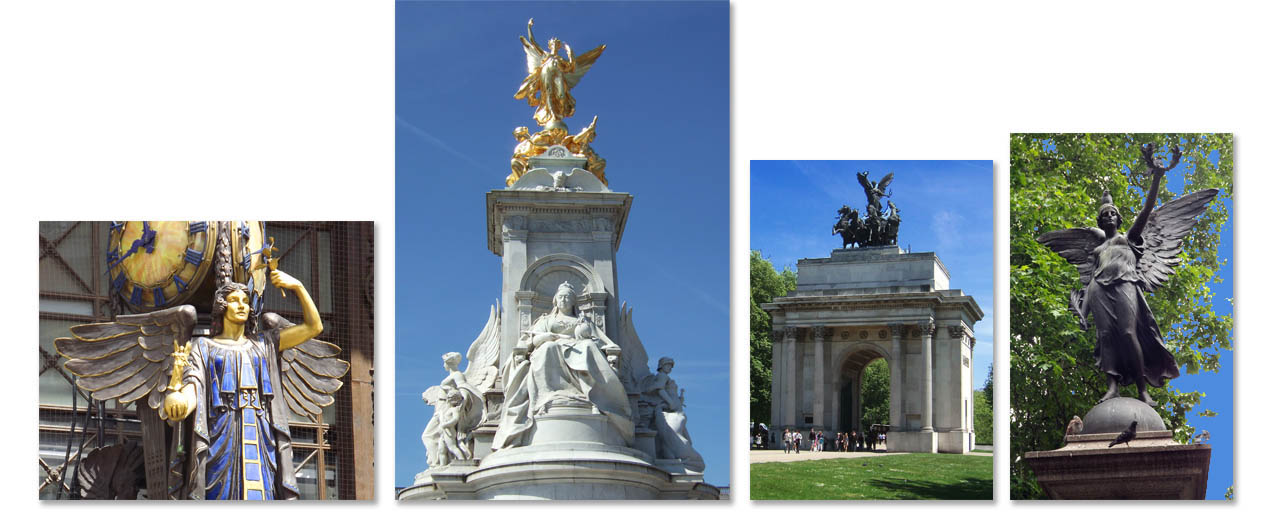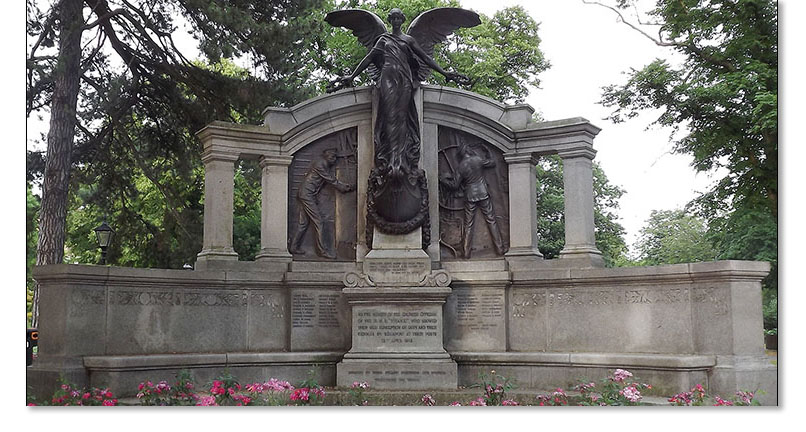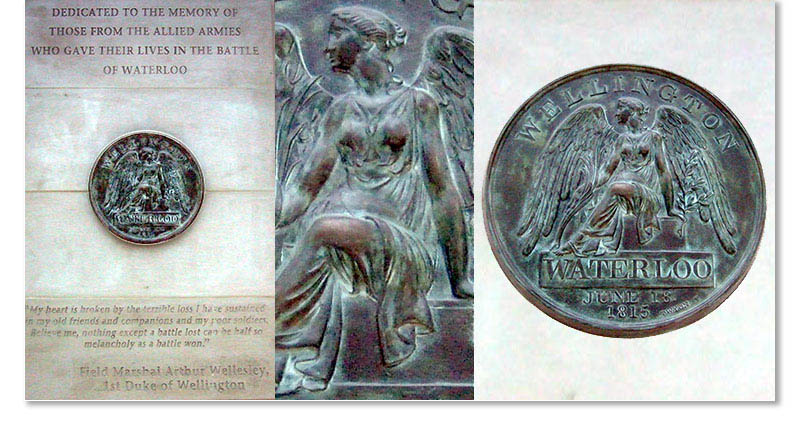How important the goddess Nike was in classical antiquity and Nike's influence on our culture today - is the story of the adaption and survival of a unique and powerful archetype. Historically, the temple dedicated to Nike is situated upon the right bastion of the Propylaea. Visitors to the
Acropolis in Athens walk up the central staircase with the little temple on their right.
Proportionally, the little building was more heavily adorned than any Ionic temple in the history of Greek architecture.
Nike in the western world and Victorian culture
The goddess Nike is found in every country in the world. In churches, Cathedrals, war memorials, symbols of peace, graveyards and cemeteries. As honorific statues to mark great achievement in the field of sport and the arts.
She often appears by herself, and frequently those using her image do not have the faintest clue who she is - or of her classical pedigree from Greek antiquity. Take a walk around any Christian burial ground, cemetery or crematorium and you will find hundreds of winged angels looking over, perhaps protecting, the dead. These statues are not put up as the Goddess they probably represent though. Generally they are thought of as nameless angels, sometimes as a representation of the Virgin Mary, but they all come from Nike.
On the battlefield Nike flew to individual victors, giving succour to power them on. Of all the Gods and Goddesses of the ancient times Nike is still one of the most used in our society (see left). Victoria, great queen of Britain, is named after none other than Nike.
It is understood that the Ark of the Covenant, that held the tablets received by Moses from the God of the Jews, was decorated with carvings of winged angels. The 'mascot' of the Rolls Royce car had wings; she was beautiful and lithe and she was based on Nike. One of the most successful sports apparel manufacturers in the world adopted Nike; they have her name and use her shamelessly to promote their goods. Make no mistake – Nike would love this affirmation of her status as the Goddess of winners, the association with contests and sport is absolutely part of what she was about.
Another huge movement adopted Nike, maybe unknowingly, but nevertheless the consequences of this adoption are huge. Christian iconography has used the sculptural form of Nike to represent angels in virtually every sect and path it has taken. The influence of the Christian faith on Italian renaissance art is indisputable and European sculptors have borrowed the image of Nike from the 14th century onwards. So how does a powerful religion square the use of pagan symbols to represent Christian concepts? Of course social and political manoeuvrings and manipulations come into play, controlling a mass of people and ensuring that they adhere to the rules devised to keep power where it is already lodged would necessitate a certain amount of rewriting history.
Nike is the result, or so legend and ancient lore has it, of a union between the great giant Pallas and the infernal River Styx. Perhaps it is the notion of water flowing that opened the eyes of Greek sculptors when they were creating her images. Nike’s affect on Greek sculpture was phenomenal. For the first time representation of a Goddess dealt in detail on the body beneath the robes. Called the wet style, this fluid movement is sensual and erotic without being gross or inappropriately sexual.
Today Nike is omnipresent; she is in literature, on greetings cards, in the stained glass windows of churches. She is used as company logos, found in paintings and posters - from South America to Africa, Europe to Asia, wherever you stop and look Nike will be found at all levels of society.
We can say perhaps just a little tongue in cheek, that Nike the goddess gave succour to competitors, libations to victors and was probably the first erotic pin up girl in western civilization.
Metropolitan Nike
In any European capital city around the world you will find Nike. It is no coincidence that London, capital city of the United Kingdom and centre of what was the 'Victorian era' displays this goddess throughout its great metropolis. On the Victoria monument in front of Buckingham Palace she stands triumphant above queen Victoria, an earthly regent overseen by the Greek Goddess of victory herself. Victory of course being the Roman name for Nike - in the empire that adopted her as their own, as indeed did the Victorians after them.
The Napoleonic Wars saw the heroes of the British army and navy triumphant. These heroes are celebrated in sculptures on monuments such as Wellington Arch. Within St. Pauls Cathedral you will find sculptures of the fallen embraced by 'Victory' (Nike). Nike is on Marble arch. She is on memorials commemorating the first world war as well as more modern examples such as Selfridges in London. This has 'the queen of time' an art deco Nike holding a Nike from classical antiquity.
Nike Worldwide
Nike is also found worldwide. On civil war monuments in the USA. War memorials in Canada. Embodied as Angels of peace from South America to Australia. She even appears in Japan as a manga character. She is the universal symbol of Victory. On Olympic medals and football trophies. Nike inspired the Rolls Royce silver lady figurine. She is so ingrained into our world that we forget her classic pedigree. Religions have adapted her physical attributes into Angels. Nike is the messenger of victory: - 'Angelos' (from the Greek, meaning messenger).
NIKE IN GREECE
Images and sculptures of Nike have been found at all the major sanctuaries in Greece. Her presence in antiquity is almost obligatory it seems. The museum at Delphi displays a reasonably sized section of the wing from a Nike statue, protected under glass, that retains most of the painted detail. This fragment gives us a fascinating insight into the use of colour on statues and temples throughout classical Greece. They were never left plain or unadorned and the palette was extensive.
Above - 1: Nike in the Stoa of Attalos, Agora Museum. Athens. 2: display plynth near the University of Athens, Panepistimiou Street. 3: Acroterion from the temple of Artemis at Epidaurus. 4: Acroterion from the temple of Asklepius, Epidaurus (holding a partridge). 5: Nike adjusting her sandle from the parapet of the temple of Athena Nike, Athens.
At the National Archaeological Museum in Athens Nike is found in a striking pose - holding a partridge rather than a dove. The partridge is a symbol of the healing power of Asklepios, and this statue was created by the sculptor Timotheos around 380 BC. The museum also displays a frieze showing Nike leading a bull to sacrifice. The resemblance to one of the parapet friezes of the Athena Nike temple on the Acropolis at Athens is striking, and it would seem that the sculptor has been inspired by the original to such an extent that he has almost copied it complete.
Nike’s image at Epidaurus, again by Timotheos, is dramatic and imposing. In the museum at Epidaurus it can be found quite high up on the wall, sadly only the upper torso and a partial wing survives. But even these fragments give us an idea of how this piece was a tour-de-force of action. The original must have been truly impressive.This great sculpture adopts the new style of representation that gained much ground, and later of course revolutionised Renaissance art as well as Greek sculpture of the time. The style is often referred to as the wet-style, and differed completely from the previously staid and respectful, almost asexual, style that was used before.
The wet style captures a moment in action, movement in stone, in a way that celebrates the physical aspects of the gods and the incredible artistic ability and achievement of the artists. The style is much celebrated in the genre of photojournalism today, with high-speed shutters and long zoom lenses – it is however, so much more impressive that artists were able, two and a half thousand years ago to see, retain and translate the moment without relying on the high speed camera.
NIKE INSPIRES
In the UK the 'Spirit of Ecstasy', or in the US: 'The Flying Lady', is the hood ornament on the front of a Rolls-Royce car. Its form is that of a female leaning forwards - as if in flight - or about to ascend. Her arms are outstretched behind her and 'meld' into her rippling garment (perhaps an Athenian peplos ?) that resemble wings.
Claude Johnson The managing director of Rolls-Royce commissioned English sculptor Charles Robinson Sykes to create a design that conveyed dignity, grace and speed.
Although we have various stories and opinions as to the original inspiration for the figurine. She is most obviously the symbol of speed and excellence that Rolls Royce implemented to glamourise their range of automobiles. This brief then was to evoke a 'spirit of mythical beauty'. Nike, in the Louvre was the original inspiration for this sculptural grace. Also the powerful archetypal representation of speed, unrivalled excellence that leads to victory in all things, in this case peerless engineering, and just the image Rolls Royce projected.
She was a great success.
Now we have a fabulous example of classic antiquity influencing the premier car manufacturer of the 20th Century. The symbol of crowning excellence. Rolls Royce certainly 'got it' when they sculptured the figurine. A mascot that had real blue blood (Olympian in this case).

The Engineers' Titanic Memorial
The Titanic Engineers' Memorial is located in Southampton (England). It is dedicated to the bravery and heroism of the Titanic engineers who lost their lives when the Titanic sank on 15 April 1912. The memorial stands in East (Andrews) Park surrounded by trees.
This granite and bronze memorial (officially a Grade II listed building) was erected by fellow engineers and friends of the Titanic engineers. Originally unveiled on April 22, 1914, by Sir Archibald Denny, president of the Institute of the Marine Engineers to a crowd of almost 100,000 people. The bronze statue of the Winged Goddess Nike dominates the centrepiece and was created by Trieste-born sculptor
Romeo Rathmann. Carved (relief) panels to either side of Nike represent the engineer officers of the ship who died in the disaster of 2012. The memorial was substantially restored in 2010.
Nike and War
War memorials have an ancient pedigree, indeed one of the most famous in history comes form Hellas. The Greek victory over the Persians at the Battle of Thermopylae in 480 BC set a standard that we have inherited today, especially to commemorate armed conflict. That we should turn to the world of classical antiquity to symbolise and confirm Victory, to commemorate the dead and console us for our lost and wounded says a lot about humanity. That we adopted Nike as a symbol of victory and later as the feminine icon of peace is astonishing. Nike's image was by now adapted into Christianity. But also separate from it historically. Nike now had a dual nature, one as the symbol of victory in war. Secondly in Christian iconography as a heaven sent ministering angel of peace over the glorious dead and wounded.
Throughout the UK you will find Nike represented as a symbol of Victory. Also as an Angel of peace. Towns and villages from Chichester to Manchester. World wide - Canada,
the USA - as well as central Europe have all erected statues of Nike on memorials to commemorate those lost in conflict. Our gallery (left column) is a selection of war
memorials in the United Kingdom. Nike is still with us - from over two and a half millenia ago shows how important a role she still has
in the life of humanity, and will always have to us.

200th anniversary of the battle Waterloo.
A new memorial commemorating soldiers who died in the Battle of Waterloo was unveiled in 2015 at London Waterloo station. The memorial was created, funded and installed by The London Mint Office. The centrepiece of the memorial displays a replica of the Waterloo campaign medal, created in bronze depicting Nike - Greek goddess of victory. The Waterloo campaign medal was originally commissioned to be presented to all soldiers present at the battle of Waterloo, irrespective of their rank.


